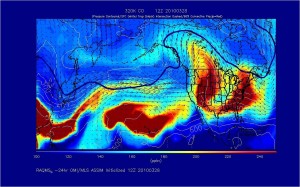By Penny Paugh
Researchers have launched the 5-phase HIPPO (HIAPER Pole-to-Pole Observation) project that generates detailed mapping, vertically and across latitudes, of the global distribution of greenhouse gases, black carbon and related chemical species in the atmosphere. Scientists hope HIPPO’s detailed view will allow them to more realistically approximate the global atmosphere’s chemical distribution and improve understanding of how the land, ocean and atmosphere interact.
The project is supported by the National Science Foundation, the National Oceanic and Atmospheric Administration, NASA, and a number of universities. After launching its proof of concept in spring 2008, the series of global flights began in January 2009 with subsequent flights occurring twice in 2010 and 2011.
The project collected seasonal data to amass a year-round perspective on global atmospheric processes. In the first three missions, occurring during Northern Hemisphere’s fall, winter and early spring, the scientists noted significant changes in carbon dioxide (CO2) distribution and concentration.
Overlaying the same slices of atmosphere in seasonal order, it is possible to see build-up of CO2 concentrations in the atmosphere over fall, winter, and spring. Not surprisingly, during the spring and summer more CO2 is consumed and more oxygen produced due to increased vegetation.
HIPPO observations also show a more widespread, uniform distribution of black carbon than anticipated, with greater than expected abundances occurring at high latitudes in the Northern Hemisphere. Additionally, concentrations of nitrous oxide (N2O), the third most important long-lived anthropogenic greenhouse gas (the other two being CO2 and methane), are higher than expected in the mid- and upper-tropical troposphere than at the surface.
Using HIPPO data, researchers will be able to test the accuracy of existing atmospheric models to better identify those that most accurately represent what is observed. Moreover, these observations will aid the design of more innovative models and data-assimilation systems. Such improvements will push forward understanding of the processes responsible for uptake of human-emitted CO2.
Reference
Hauser R., National Center for Atmospheric Research. A HIPPO Takes to the Skies to Taste Earth’s Atmosphere, October 14, 2011, Live Science, retrieved from: http://www.livescience.com/16559-hippo-atmosphere-testing-nsf-bts.html


Comments are closed.